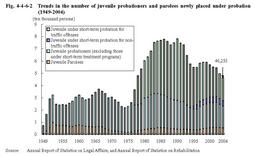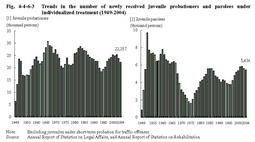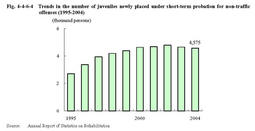| Previous Next Index Image Index Year Selection | |
|
|
1 Trends in number of juvenile probationers/parolees (1) Total number Fig.4-4-6-2 shows the number of juvenile probationers and parolees newly placed under probation since1949.
The total number increased drastically since1977,when short-term probation for traffic offenses was introduced,but has been on a decreasing trend due to a decrease in juvenile under short-term probation for traffic offenses,standing at46,253(down by7.1%from the previous year)in2004. Fig.4-4-6-2 Trends in the number of juvenile probationers and parolees newly placed under probation(1949-2004) (2) Juvenile probationers/parolees under individualized treatment Fig.4-4-6-3 shows the number of newly received juvenile probationers and parolees under individualized treatment since1949.
Fig.4-4-6-3 Trends in the number of newly received juvenile probationers and parolees under individualized treatment(1949-2004) (3) Juveniles under short-term probation for non-traffic offenses In addition to ordinary probation/parole supervision,there are short-term probation for non-traffic offenses and short-term probation for traffic offenses determined by recommendation concerning treatment by a family court.
Short-term probation for non-traffic offenses is for a juvenile who is placed under probation by a family court order for any offense other than traffic-related ones(unsafe driving resulting in death or injury in traffic accident,professional negligence in traffic accidents,violations of four statute traffic related laws,and Road Trucking Law violations;hereinafter the same in this Section)as long as the juvenile has not developed strong delinquent tendencies and is expected to improve and rehabilitate him/herself during the short-term period.It is conducted for the short period of six or seven months in principle.In the probation of a juvenile,individualized treatment is conducted,focusing on his/her lifestyle,school life,employment,family relationships,or friends etc.that he/she has problems with and is particularly important for his/her rehabilitation.Some assignments are given for him/her to perform designed to help him/her solve their problems. Fig.4-4-6-4 shows the number of juveniles newly placed under short-term probation for non-traffic offenses. Fig.4-4-6-4 Trends in the number of juveniles newly placed under short-term probation for non-traffic offenses(1995-2004) (4) Short-term probation for traffic offenses Short-term probation for traffic offenses is for a juvenile who is placed under probation by a family court order for traffic-related offenses as long as the juvenile does not have general delinquent tendencies or has not developed strong delinquent tendencies and his/her traffic-related delinquent tendencies are not fixed.It is conducted for a short period of three or four months in principle.Instead of individualized treatment,group treatment concerning safe driving is conducted.
Fig.4-4-6-5 shows the number of juveniles who were newly placed under short-term probation for traffic offenses,those who were discharged from such probation,and group sessions organized for them over the last five years. Table4-4-6-5 Number of juveniles newly placed under short-term probation for traffic offenses,those discharged from such probation,and group sessions organized for them(2000-2004) |



